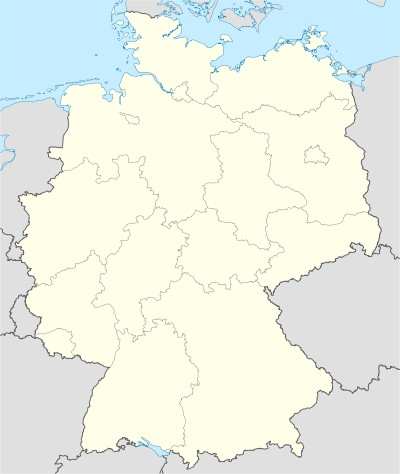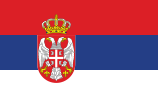Ingolstadt
| Ingolstadt | |
|
|
|
 |
|
 Ingolstadt
|
|
| Coordinates | |
| Administration | |
| Country | Germany |
|---|---|
| State | Bavaria |
| Admin. region | Upper Bavaria |
| District | Urban district |
| City subdivisions | 11 Stadtbezirke with 61 Unterbezirken |
| Lord Mayor | Alfred Lehmann (CSU) |
| Basic statistics | |
| Area | 133.35 km2 (51.49 sq mi) |
| Elevation | 400 m (1312 ft) |
| Population | 124,387 (31 December 2009)[1] |
| - Density | 933 /km2 (2,416 /sq mi) |
| Other information | |
| Time zone | CET/CEST (UTC+1/+2) |
| Licence plate | IN |
| Postal codes | 85049–85057 |
| Area codes | 0841 08450(Zuchering, Brunnenreuth) 08424(Irgertsheim) |
| Website | www.ingolstadt.de |
Ingolstadt (German pronunciation: [ˈɪŋɡɔlˌʃtat]; Austro-Bavarian: Inglstådt) is a city in the Free State of Bavaria, Germany. It is located along the banks of the Danube River, in the center of Bavaria. As of December 31, 2005, Ingolstadt had 121,801 residents. It is part of the Munich Metropolitan Area with a population of more than 5 million.
Ingolstadt is mentioned in the novel Frankenstein by Mary Shelley. It is the birthplace of the monster as created by the scientist Victor Frankenstein.
The Illuminati, a Bavarian secret society, was founded in Ingolstadt in the late 18th century.
The headquarters of the German automobile manufacturer Audi are located in Ingolstadt, as well as the headquarters of the electronic stores Media Markt and Saturn. Ingolstadt Central Station has been connected to Nuremberg by a high-speed rail link since May 2006. Ingolstadt also has a second passenger station at Ingolstadt Nord.
Contents |
History and culture

Ingolstadt was first mentioned in a document of Charlemagne on 6 February 806 as "Ingoldes stat", the place of Ingold. Circa 1250, Ingolstadt was granted city status.
Ingolstadt was the capital of the duchy Bavaria-Ingolstadt between 1392 and 1447. Ingolstadt was then united with Bavaria-Landshut. Louis VII, Duke of Bavaria ordered the building of the New Castle, which is strongly influenced by French Gothic architecture. In 1472 Louis IX, Duke of Bavaria founded the Ludwig-Maximilians-University in Ingolstadt, which was moved to Landshut in 1800 and finally to Munich.
On 30 April 1632, the German fieldmarshall Johann Tserclaes, Count of Tilly died in Ingolstadt, during the Swedish siege. The fieldmarshall had been badly hurt in a previous engagement with the Swedes under King Gustavus Adolphus. Ingolstadt proved to be the first fortress in Germany that held out for the entire length of the Swedish siege, and the Swedes eventually withdrew.
The horse of Gustavus Adolphus can be seen in the City Museum. It was shot from under the king by one of the cannons inside the fortress. The cannon was known as "The Fig". When the Swedes withdrew, the remains of the horse were preserved, and it was eventually put on display, and has remained so for almost 400 years.
Originally a fortress city, Ingolstadt is enclosed by a medieval defensive wall. The Bavarian fortress (1537–1930) nowadays holds the museum of the Bavarian army. During World War I, future French president Charles de Gaulle was detained there as a prisoner of war. A sappers' drill ground is still crossing the river, two military air bases are nearby, one used for testing airplanes. The long military tradition of the city is reflected in today's civil and cultural life. Former "off-limit" grounds are now well-used public parks.
Ingolstadt was the city where William IV, Duke of Bavaria wrote and signed the Bavarian Reinheitsgebot in 1516. Adolf Scherzer composed the "Bayerischen Defiliermarsch", and Mary Shelley's Frankenstein is related to the Ingolstädter Alte Anatomie (Old Anatomy Building), now a museum for medical history. In 1748, Adam Weishaupt, the founder of the Order of Illuminati, was born in Ingolstadt. The famous writer Marieluise Fleißer wrote Pioniere in Ingolstadt in 1928.
Main sights
As one of five ducal residences of medieval Bavaria next to Landshut, Munich, Straubing and Burghausen, the city of Ingolstadt features many gothic buildings, such as the Herzogskasten (Old ducal castle; ca. 1255) and the New Castle, which was built from 1418 onwards. The largest church is the gothic hall Church of Our Lady which was begun in 1425. Also the churches of Saint Maurice (1235) and of the monasteries Gnadenthal and of the Franciscans date from the gothic era. The Kreuztor (1385) is one of the remaining gates of the old city wall. The gothic Old City Hall was also constructed in the 14th century, but later altered several times.
The baroque era is today still represented by the Old Anatomy Building of the university (1723–1736, by Gabriel de Gabrieli) and the church St. Maria de Victoria which was built by the Asam brothers (1732–1736), while the church of the Augustinians of Johann Michael Fischer (1736) was completely destroyed in World War II.
Many buildings of the neo-classical fortification of Leo von Klenze have been preserved, such as the Reduit Tilly and the towers Baur und Triva.
Schools
Ingolstadt School of Management
Ingolstadt is home of one of Germany's foremost business schools: the Ingolstadt School of Management. It's the department of business administration and economics of the "Catholic University of Eichstaett-Ingolstadt."
In national rankings, the B-school regularly scores among the top ten, which is due to its high academic quality and excellent student:professor ratio. The faculty maintains a vast network of partner universities for international educational exchange.
Currently, the Ingolstadt School of Management offers bachelor's and master's degrees in business administration ( German: BWL - Betriebswirtschaftslehre). Among the academic programs offered are also an executive MBA and doctoral degrees.
University of Applied Sciences
The University of Applied Sciences Ingolstadt is a new and dynamic university for technology, computer sciences and business administration. With around 2500 students the University is the biggest institution of learning in Ingolstadt.
Classes are small and students receive individual attention. The close interaction between professors, instructors and students creates a pleasant contrast to studying at a larger universities.
Several scholarship programs supported by companies such as Siemens and Temic provide gifted students with financial assistance during their studies. These students deepen their practical experience by working at these organizations.
The University of Applied Sciences Ingolstadt offers several Undergraduate and Graduate Programs. Every Program is listed under the top 25 in Germany.
Literary references
Ingolstadt is one of the many settings in Mary Shelley's novel Frankenstein. Primarily, Victor Frankenstein attends university in Ingolstadt. The musical version of the novel, Frankenstein - A New Musical has many scenes set in Ingolstadt.
Ingolstadt is also a pivotal location in The Illuminatus! Trilogy by Robert Shea and Robert Anton Wilson.
Dr. Faust is mentioned in an old and short local tale.
The X-Files episode "The Post-Modern Prometheus" makes a reference to the University of Ingolstadt. This was an allusion to Frankenstein, as the episode was filled with Frankenstein references, and the full title of Frankenstein is actually "Frankenstein: or, The Modern Prometheus" (also see: Prometheus).
International relations
Several other cities are sister cities to Ingolstadt:
 Győr, Hungary
Győr, Hungary Kirkcaldy, Fife, UK
Kirkcaldy, Fife, UK Grasse, France
Grasse, France Carrara, Italy
Carrara, Italy Kragujevac, Serbia
Kragujevac, Serbia Manisa, Turkey
Manisa, Turkey Opole, Poland [2]
Opole, Poland [2] Central District, Moscow, Russia
Central District, Moscow, Russia Murska Sobota, Slovenia
Murska Sobota, Slovenia
Organizations and clubs
- MTV 1881 Ingolstadt, Ingolstadt's major sports club
- FC Ingolstadt 04, Footballclub in 2. Bundesliga (II)
- Grün-Weiß Ingolstadt, Footballclub in Kreisklasse (IX)
- Ingolstadt Schanzer, Baseball team in 2. Bundesliga (II)
- ERC Ingolstadt, Icehockey team in DEL (I)
See also
- University of Ingolstadt
References
- ↑ "Fortschreibung des Bevölkerungsstandes" (in German). Bayerisches Landesamt für Statistik und Datenverarbeitung. 31 December 2009. https://www.statistikdaten.bayern.de/genesis/online/online?sequenz=statistiken&selectionname=12411.
- ↑ "Opole Official Website - Twin Towns".

 (in English and Polish) © 2007-2009 Urząd Miasta Opola. http://www.opole.pl/miasto/index.php?option=com_content&task=blogcategory&id=20&Itemid=108. Retrieved 2009-06-18.
(in English and Polish) © 2007-2009 Urząd Miasta Opola. http://www.opole.pl/miasto/index.php?option=com_content&task=blogcategory&id=20&Itemid=108. Retrieved 2009-06-18.
External links
- Ingolstadt Official website of the city (in German)
- Catholic University Eichstätt-Ingolstadt
- University of Applied Sciences (Fachhochschule)
- Museum of the Bavarian Army (in German)
- Audi
- A history of Ingolstadt by Kurt Scheurer (in German)
- A biography of Marieluise Fleißer (in German)
- Pioniere in Ingolstadt by Marieluise Fleißer (in German)
|
||||||||||||||
|
||||||||
|
||||||||||||||||||||
